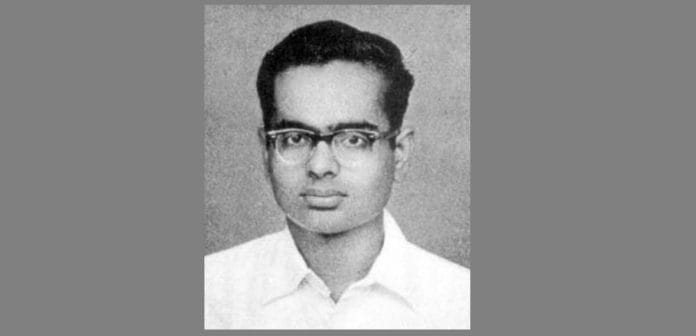Often confused with Srinivasa Ramanujan, C.P. Ramanujam was an equally gifted mathematician known for his work on algebraic number theory and geometry.
New Delhi: Protesting for not getting a promotion might not sound very unusual but doing so for being awarded one certainly does. That’s exactly what C.P. Ramanujam did when he was promoted as an associate professor at the Tata Institute of Fundamental Research (TIFR). Believing that the promotion was undeserved, Ramanujam, a schizophrenic patient, accepted it only after repeated requests from his friends.
A brilliant mathematician, often confused with Srinivasa Ramanujan, who is considered India’s greatest mathematician, C.P. Ramanujam is best known for his work on algebraic number theory and algebraic geometry.
Today, 9 January, is the birth anniversary of Ramanujam, and ThePrint looks at the life of this celebrated scholar.
Early Life
Born in 1938 to C.S. Padmanabhan, a Madras High Court advocate, Ramanujam completed high school in 1952, and thereafter, joined the prestigious Loyola College in Madras (now Chennai) for his intermediate and bachelors.
Finishing the latter with a specialisation in mathematics in 1957, he decided to join the Tata Institute of Fundamental Research in Bombay (now Mumbai) on the recommendation
of Father C. Racine. A Jesuit priest who had obtained his PhD from Paris and joined Loyola in 1939, Father Racine was able to identify the mathematical genius of a young Ramanujam.
Also read: Remembering Satish Dhawan, the science wizard who pioneered India’s space programme
TIFR days and scholarly contributions
Ramanujam’s first two papers, published in 1963, were on Waring’s problem for algebraic number fields. He undertook research in this area on the suggestion of his PhD guide at TIFR, K.G. Ramanathan, and decided to explore a problem set out by the great German number theorist C.L. Siegel.
B.J. Birch, himself a great number theorist, writes that the resolution of the problem involved two parts: An algebraic proof and an analytic local-to-global argument.
Highlighting Ramanujam’s contribution, he further mentions that even though “a local-to-global argument…. was cobbled together in 1961…. this analysis was not properly understood until Ramanujam published his first paper”.
In the second paper, Ramanujam dealt with the algebraic half of Siegel’s problem and produced a result that has never been improved.
During that period at TIFR, Ramanujam, because of his expertise, also began to write lecture notes for the courses that were delivered by renowned mathematicians from across the world at TIFR. He earned significant praise for it as well.
For instance, Russian mathematician I.R. Shafarevich remarked, “I want to thank [Ramanujam] for the splendid job he has done. He not only corrected several mistakes but also complemented proofs of many results that were only stated in oral exposition.”
Similar praise was earned from David Mumford, a Fields Medal winner, as he later recounted, “I first met him [Ramanujam] in Bombay in 1967-68, when he took notes on my course in Abelian Varieties and we worked jointly on refining and understanding many points related to this theory.”
In the introduction of his book, Abelian Varieties, he also mentions, “This book is based on a series of lectures delivered in the winter of 1967-68 at the Tata Institute of Fundamental Research. These lectures were subsequently written up, and improved in many ways, by C P Ramanujam. The present text is a joint effort.”
Ramanujam also made important contributions to algebraic geometry, including contribution towards clarification of the Kodaira Vanishing Theorem.
Struggle with depression and schizophrenia
Throughout his career, Ramanujam was plagued with severe bouts of depression and was diagnosed with schizophrenia in 1964. It frequently affected his research work and made him doubt his ability as a mathematician.
At one point during his early days at TIFR, he became so convinced about his inability to pursue original research that he started applying for teaching positions at other places. Fortunately, his applications were rejected and he remained at TIFR.
Similarly, in 1965, he joined Panjab University as a professor but left it after eight months to return to TIFR. A year later, during a six-month stint at Institut des Hautes Études Scientifique in Paris, he cut it short and returned to India.
Finally, in 1974, at the age of 36, he took his own life by overdosing on barbiturates.
It’s indeed remarkable that two of India’s greatest mathematicians — Ramanujam and Ramanujan (who passed away aged 32) — died so young, and yet left such an enduring legacy in their discipline.
Also read: Birthday tribute to Satyendra Nath Bose, the physicist after whom Higgs boson particle is named
Tributes
The extent of Ramanujam’s contributions to mathematics can also be gauged from some of the tributes he has received over the years.
“He had very high standards….He was sometimes tormented by the difficulty of these high standards, but, in retrospect, it is clear to us how often he succeeded in adding to our knowledge and results, both new, beautiful and with a genuinely original stamp,” wrote Mumford.
“Ramanujam published far too little, and was clearly the sort of mathematician whose paper napkins needed to be preserved for posterity,” remembered B.J Birch. “In his writings, Ramanujam strove for extreme lucidity, though his aversion to saying anything unnecessary was not always helpful.”
Ramanujam’s contemporary from TIFR, and a brilliant mathematician himself, Ramanan said, “For sheer elegance and economy, I have come across few mathematicians who were C.P. Ramanujam’s equal.”







Informative inspiration to the mathematics people to work more and more